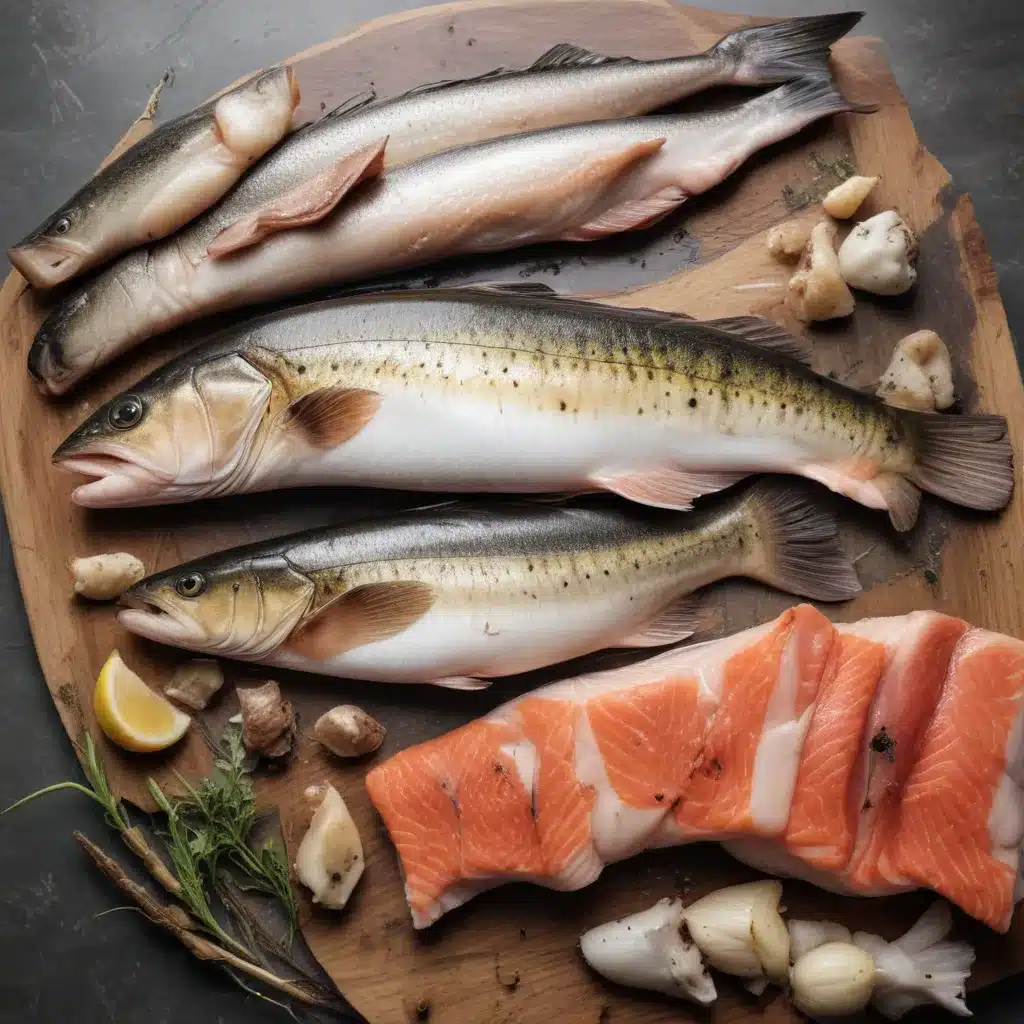
The world of seafood is vast and captivating, but few fish command the reverence and culinary prowess of the humble cod. As a seafood dining expert writing for Fish Tales Cafe, I’m here to guide you on a journey through the intricate landscape of this remarkable, versatile fish.
Cod Varieties and Characteristics
Cod, belonging to the Gadidae family, is a popular whitefish found in the cold, nutrient-rich waters of the North Atlantic and North Pacific Oceans. The most well-known varieties include Atlantic cod, Pacific cod, and Alaskan cod, each with its own subtle flavor profile and textural nuances.
Atlantic cod, often referred to as the “king of whitefish,” is prized for its flaky, firm flesh and mild, slightly sweet taste. Pacific cod, on the other hand, tends to have a slightly firmer texture and a more pronounced, almost savory flavor. Alaskan cod, a close relative of the Pacific variety, boasts a delicate, delicious character that has made it a staple in many coastal cuisines.
Sourcing Exceptional Cod
When it comes to selecting the finest cod, the key is to seek out responsibly sourced, ethically caught fish. Look for cod that is wild-caught, sustainably fished, and traceable to its origin. Reputable seafood purveyors and specialty markets are excellent sources for finding high-quality, dependable cod.
One of the hallmarks of exceptional cod is its freshness. Fresh cod should have a firm, elastic texture, clear eyes, and a clean, briny aroma. Avoid cod that appears dull, discolored, or has a strong, fishy odor, as these are signs of deterioration.
Cod Storage and Preservation
Proper storage is essential to maintaining the delicate flavor and texture of cod. Fresh, raw cod should be stored in the coldest part of your refrigerator, ideally around 32-34°F (0-1°C). Wrap the fillets tightly in plastic wrap or place them in a sealed container to prevent drying and oxidation.
For longer-term storage, frozen cod is an excellent option. When freezing cod, be sure to wrap the fillets tightly in plastic or place them in a resealable freezer bag, removing as much air as possible. Properly frozen cod can maintain its quality for up to 6-8 months.
To thaw frozen cod, transfer the fillets to the refrigerator and allow them to thaw gradually, which can take 12-24 hours, depending on the size of the portions. Avoid thawing cod at room temperature, as this can promote the growth of harmful bacteria.
Cod Culinary Appreciation
Flavor Profiles of Cod
Cod’s mild, delicate flavor makes it a versatile canvas for a wide range of culinary applications. The fish’s natural sweetness pairs beautifully with bold, aromatic seasonings, as well as more subtle, delicate flavors. Depending on the preparation method, cod can take on nuances of buttery richness, delicate nuttiness, or a clean, oceanic essence.
Cooking Techniques for Cod
Cod’s firm yet flaky texture lends itself well to a variety of cooking methods, from baking and pan-searing to poaching and steaming. One particularly popular technique is sous vide, which allows the cod to gently cook in a water bath, resulting in perfectly tender, evenly cooked fillets.
Another classic cod preparation is en papillote, where the fish is sealed in a parchment paper or foil packet and baked, steaming the cod in its own juices and infusing it with the flavors of the accompanying ingredients.
Pairing Cod with Complementary Ingredients
Cod’s mild flavor makes it an excellent pairing for a wide array of ingredients. Classic combinations include cod with citrus (such as lemon or lime), herbs (like dill or parsley), and earthy vegetables (such as roasted potatoes or sautéed spinach). For a heartier meal, cod pairs beautifully with heartier grains, legumes, or white wine-based sauces.
Sustainable Cod Practices
Environmental Considerations
As responsible seafood enthusiasts, it’s crucial to consider the environmental impact of our seafood choices. Fortunately, many cod fisheries around the world have implemented sustainable practices to ensure the long-term viability of this important resource.
Responsible Fishing Methods
Look for cod that is certified by organizations like the Marine Stewardship Council (MSC), which verifies that the fish was caught using responsible, low-impact methods that minimize bycatch and habitat disruption.
Traceability and Labeling
When purchasing cod, pay attention to the labeling and origin information. Opt for cod that is traceable to its source, allowing you to make informed choices about the environmental and social impact of your seafood consumption.
The Discerning Cod Enthusiast
Cod Tasting and Evaluation
For the true cod connoisseur, tasting and evaluating the nuances of this remarkable fish is a rewarding endeavor. Consider the cod’s texture, from the flaky and tender to the firm and robust. Savor the subtle flavors, noting the balance of sweetness, saltiness, and even a hint of umami.
Culinary Trends and Innovations
As the seafood landscape continues to evolve, cod remains a steadfast favorite, inspiring chefs and home cooks alike to explore new and innovative ways to showcase its versatility. From creative gluten-free preparations to global seafood traditions, the possibilities for cod are endless.
Cod in Gourmet Cuisine
In the realm of gourmet cuisine, cod shines as a canvas for culinary artistry. Michelin-starred chefs around the world have elevated cod to new heights, pairing it with unexpected ingredients, employing advanced cooking techniques, and crafting mouthwatering wine pairings that enhance the fish’s natural qualities.
Whether you’re a seasoned seafood enthusiast or a newcomer to the world of cod, I hope this guide has inspired you to explore the depths of this remarkable fish. From sustainable sourcing to innovative culinary applications, the cod connoisseur’s realm is a realm of endless discovery and delight. Happy cooking, and may your cod experiences be truly exceptional!

